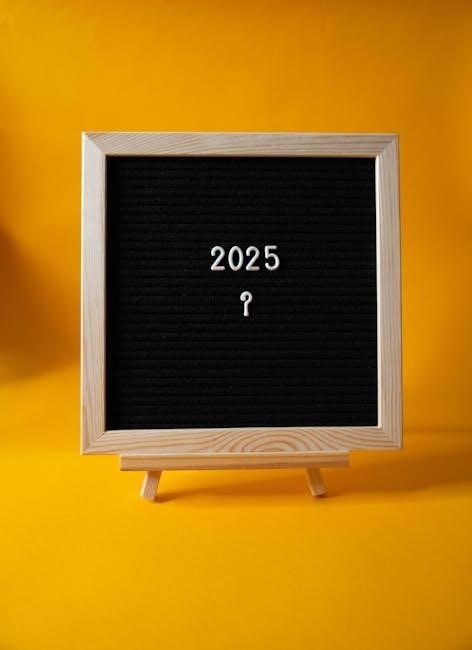Problem-solving is a critical skill for 4th graders, enhancing their ability to think logically and apply math to real-life situations. It fosters independence, creativity, and analytical thinking while building confidence in tackling challenges. Through guided exploration and interactive activities, students learn to break down problems, identify unknowns, and develop step-by-step solutions. This foundational skill is essential for their academic and personal growth.
1.1 Importance of Problem Solving Skills
Problem-solving skills are essential for 4th graders as they develop logical thinking, critical reasoning, and creativity. These skills enable students to tackle real-world challenges confidently, fostering independence and resilience. By mastering problem-solving, learners improve their ability to analyze situations, make informed decisions, and apply mathematical concepts effectively in various contexts, laying a strong foundation for future academic and personal success.
1.2 Skills Developed Through Problem Solving
Problem-solving enhances critical thinking, logical reasoning, and mathematical reasoning. Students develop creativity, analytical thinking, and the ability to approach challenges methodically. These skills improve their understanding of mathematical concepts and their application in real-world scenarios. Problem-solving also fosters confidence, resilience, and the ability to articulate solutions clearly, preparing students for future academic and personal challenges.

Key Steps in Problem Solving
Problem-solving involves identifying the unknown, setting up equations, solving them, and verifying solutions. These steps help students apply math to real-world situations and think logically.
2.1 Defining the Unknown
Defining the unknown is the first step in problem-solving, where students identify what needs to be found. This involves reading the problem carefully, highlighting key information, and determining the missing value or quantity. Clear identification ensures the problem is approached accurately, setting a solid foundation for setting up equations and solving them effectively.
2.2 Setting Up the Equation
Setting up the equation involves translating the problem’s words into mathematical symbols. Students identify the operation and structure the equation based on the unknown defined earlier. For example, if Luc spends 1/4 of his pay on rent, the equation might look like: ( ext{Remaining pay} = ext{Total pay} ⎼ rac{1}{4}( ext{Total pay}) ). This step ensures the problem is accurately represented mathematically.
2.3 Solving the Equation
Solving the equation requires applying appropriate mathematical operations. Students perform calculations step-by-step to isolate the unknown. For instance, in the equation 3x + 5 = 20, they subtract 5 from both sides to get 3x = 15, then divide by 3 to find x = 5. This step involves basic arithmetic and algebraic manipulation to reach the solution efficiently.
2.4 Verifying the Solution
Verifying the solution ensures accuracy and completeness. After solving, students substitute the answer back into the original equation to check if both sides are equal. For example, if x = 5 solves 3x + 5 = 20, substituting gives 15 + 5 = 20, confirming the solution is correct. This step reinforces understanding and builds confidence in problem-solving abilities.
Math Operations in Problem Solving
Math operations like multiplication, division, addition, and subtraction are fundamental in solving problems. Students apply these skills to word problems, real-world scenarios, and fraction tasks, enhancing their problem-solving abilities and understanding of mathematical concepts.
3.1 Multiplication and Division of Natural Numbers
Multiplication and division of natural numbers are essential skills for problem-solving. Students learn to apply these operations in various contexts, such as calculating quantities, understanding groups, and solving real-world problems. Practice exercises and worksheets help reinforce these concepts, ensuring a strong foundation for more complex math challenges ahead.
3.2 Word Problems Involving Basic Operations
Word problems in 4th grade involve applying multiplication, division, and fractions to real-life scenarios. Students learn to interpret situations, identify operations, and solve step-by-step. Examples include calculating remaining salary fractions or determining discounted prices, fostering practical math application and critical thinking. These problems enhance problem-solving abilities and prepare students for everyday challenges.

Word Problems and Real-World Applications
Word problems connect math to everyday situations, making learning practical and engaging. Students apply problem-solving skills to real-world scenarios, enhancing their understanding of mathematical concepts and their relevance.
4.1 Everyday Situations and Math
Everyday situations like buying groceries, telling time, and measuring ingredients involve math. These real-world contexts help students see the practical use of problem-solving skills, making learning more engaging and relatable. By connecting math to daily life, students develop a deeper understanding and appreciation for its value in their routines and future careers.
4.2 Applying Math to Real-Life Scenarios
Applying math to real-life scenarios, such as calculating discounts or dividing resources, helps students understand practical uses of problem-solving skills. This approach encourages critical thinking and prepares them for future challenges, making math more meaningful and relevant to their everyday experiences and decision-making processes.
Time and Space Problems
Understanding time involves reading analog clocks and calculating durations, while spatial awareness includes recognizing shapes and their relationships. These skills are essential for real-world applications and logical reasoning.
5.1 Telling Time on Analog Clocks
Students learn to identify hours and minutes on analog clocks, understanding concepts like half-past and quarter intervals. This skill enhances their ability to manage time effectively in daily life and apply mathematical reasoning to real-world scenarios.
5;2 Understanding Spatial Relationships
Students explore spatial awareness through visual exercises and puzzles, recognizing shapes and their positions in space. Activities involve identifying objects’ relative locations, enhancing their ability to interpret and navigate real-world environments. Guided exploration helps develop critical thinking and spatial reasoning, essential for problem-solving in math and everyday situations.

Fraction Problems
Fraction problems introduce students to basic concepts like halves, thirds, and quarters. They learn to identify, compare, and operate with fractions through visual aids and real-life examples.
6.1 Basic Fraction Concepts
Basic fraction concepts teach students to understand parts of a whole. They learn to identify fractions like 1/2, 1/3, and 1/4 through visual representations. Comparing fractions and recognizing equivalent fractions are also introduced, building a foundation for more complex operations. Real-life examples help students grasp practical applications of fractions.
6.2 Applying Fractions in Problems
Applying fractions involves using them to solve real-world problems. Students learn to divide objects into equal parts, calculate remaining portions, and compare fractional amounts. Exercises include determining how much of a whole is represented by a fraction or finding the difference between two fractions. These skills help students apply mathematical concepts to practical scenarios, enhancing their problem-solving abilities.
Teaching Strategies
Effective teaching strategies involve guided exploration and interactive activities. Teachers use visual aids and real-life examples to help students understand and apply problem-solving concepts. This fosters deeper learning and engagement.
7.1 Guided Exploration
Guided exploration encourages students to actively participate in problem-solving by breaking tasks into manageable steps. Teachers provide prompts, visual aids, and real-life scenarios to guide students’ thinking. This method helps students develop critical thinking and independent problem-solving skills through structured yet engaging activities, fostering confidence and understanding in mathematical concepts.
7.2 Interactive and Engaging Methods
Interactive methods make problem-solving dynamic and enjoyable for 4th graders. Tools like educational apps, group activities, and hands-on exercises enhance engagement. These approaches encourage active participation, fostering a deeper understanding of mathematical concepts. Technology integration and collaborative learning further motivate students, preparing them to tackle challenges with confidence and creativity.
Activities and Exercises
Engaging activities and exercises are essential for developing problem-solving skills in 4th graders. These include puzzles, word problems, and hands-on tasks that encourage critical thinking. Outdoor activities and group projects further enhance learning, making math enjoyable and relatable. Interactive tools and worksheets provide structured practice, ensuring students master problem-solving techniques effectively.
8.1 Various Exercise Types
Various exercise types enhance problem-solving skills in 4th grade. Worksheets with word problems, such as fraction applications and multiplication/division scenarios, are common. Interactive digital tools and educational apps offer engaging practice. Group activities and outdoor tasks encourage teamwork and real-world application. These diverse exercises cater to different learning styles, ensuring comprehensive skill development and making problem-solving enjoyable and effective for all students.
8.2 Outdoor and Hands-On Activities
Outdoor and hands-on activities provide practical experience for 4th graders to apply problem-solving skills. Measuring distances, counting objects, or solving real-world math problems in outdoor settings make learning interactive and fun. These activities help bridge the gap between theory and practice, allowing students to visualize and understand mathematical concepts better while fostering teamwork and creativity in problem-solving scenarios.

Evaluation and Assessment
Evaluation and assessment are crucial for measuring students’ problem-solving skills. Tools like worksheets, quizzes, and project-based tasks help teachers understand each student’s grasp of concepts and identify areas needing improvement.
9.1 Assessing Problem Solving Skills
Assessing problem-solving skills involves evaluating students’ ability to define problems, create equations, and find solutions. Teachers use worksheets and exercises to monitor progress and understanding. These tools help identify strengths and weaknesses, ensuring targeted support for each student. Regular assessments also help track improvement over time, providing insights into the effectiveness of teaching strategies and student engagement.
9.2 Using Worksheets and Exercises
Worksheets and exercises are essential tools for reinforcing problem-solving skills. They provide structured practice, helping students apply mathematical concepts to real-world scenarios. PDF resources and exercise sheets offer a variety of problems, from basic operations to complex equations. These materials cater to different learning styles, ensuring comprehensive understanding and mastery of problem-solving techniques for 4th-grade students.

Common Challenges
Many 4th-grade students struggle with problem-solving, particularly in applying mathematical concepts to real-world scenarios. Difficulties in understanding spatial relationships and fractions are common, requiring targeted practice and support.
10.1 Difficulties in Mastering Skills
Students often face challenges in mastering problem-solving skills, particularly with fractions and spatial reasoning. These difficulties stem from limited understanding of basic concepts and translating them into practical solutions. Additionally, some students struggle with defining unknowns and setting up equations, which are crucial steps in the problem-solving process. These challenges highlight the need for tailored support and engaging teaching methods to ensure comprehension and confidence.
10.2 Strategies to Overcome Challenges
To address these challenges, educators employ various strategies, such as guided exploration and interactive activities, allowing students to engage deeply with problems. Breaking tasks into smaller steps and using visual aids also enhances understanding. Encouraging collaboration and providing positive feedback fosters a supportive learning environment, helping students build confidence and mastery in problem-solving skills over time.

Resources and Worksheets
Various PDF resources, exercise sheets, and corrigés are available online, offering structured exercises for 4th graders to practice problem-solving skills effectively and improve their understanding of mathematical concepts.
11.1 Available PDF Resources
Various PDF resources are available online, offering structured exercises and worksheets for 4th graders. These include “Gai Savoir ‒ Résoudre des problèmes en 4e année” and other exercise sheets with corrigés. They cover problem-solving strategies, math operations, and real-world applications, providing a comprehensive tool for practice and skill development. These resources are accessible for free or through educational platforms, catering to different learning needs.
11.2 Corrigés and Exercise Sheets
Corrigés and exercise sheets are essential tools for 4th-grade problem-solving. They provide detailed solutions and guided practice, covering topics like multiplication, division, and fractions. These resources include step-by-step explanations, helping students understand problem-solving strategies. Many sheets focus on real-world applications, making math relatable. Teachers and students benefit from these organized materials, which reinforce learning and offer clear examples for independent practice and review.

Technology Integration
Technology enhances problem-solving skills through interactive tools and educational apps. Digital platforms like Gai Savoir and En avant, les maths! offer engaging exercises and real-time feedback, making learning fun and accessible for 4th graders. These resources support independent practice and reinforce problem-solving strategies in a modern, student-friendly environment.
12.1 Digital Tools for Practice
Digital tools like Gai Savoir and En avant, les maths! provide interactive exercises and real-time feedback, helping students practice problem-solving skills. These platforms offer a variety of activities, from basic operations to complex word problems, making learning engaging and accessible. They support independent practice and allow teachers to track progress, ensuring students master problem-solving strategies in a fun and interactive way.
12.2 Educational Apps and Websites
Educational apps like Khan Academy and Math Games offer interactive exercises tailored for 4th-grade problem-solving. Websites such as Gai Savoir provide PDF resources and corrigés, allowing students to practice with guided solutions; These tools enhance learning by offering interactive exercises, progress tracking, and real-time feedback, making problem-solving engaging and effective for students mastering math skills at home or in the classroom.

Parental Involvement
Parents play a vital role by supporting problem-solving practice at home, providing resources, and encouraging critical thinking. Their involvement fosters a conducive learning environment, promoting academic success.
13.1 Supporting Learning at Home
Parents can support problem-solving skills by creating a study-friendly environment and providing access to resources like worksheets and educational apps. Encouraging daily practice with exercises found in PDF materials helps reinforce classroom learning. Regular communication with teachers ensures alignment with curriculum goals, fostering a collaborative effort in the child’s educational journey. Consistency and positive reinforcement are key.
13.2 Encouraging Problem Solving
Parents can encourage problem-solving by engaging children in real-world activities like cooking or budgeting, which naturally incorporate math. Discussing daily challenges and guiding them through solution steps fosters critical thinking. Praising effort and creativity, rather than just results, builds confidence and a growth mindset, helping children view problems as opportunities to learn and grow.

Cultural Context
In France, problem-solving skills are integrated into the 4th-grade curriculum, with resources like “CYCLE” and “Gai Savoir” providing structured exercises and activities to enhance learning.
14.1 Educational Context in France
In France, problem-solving skills for 4th graders are deeply integrated into the curriculum, with a focus on logical reasoning and practical applications. Resources like “CYCLE” and “Gai Savoir” provide structured exercises and activities.
These programs emphasize guided exploration and interactive methods, ensuring students develop a strong foundation in math and problem-solving, aligning with France’s educational standards and initiatives for young learners.
14.2 Specific Programs and Initiatives
France has implemented specific programs like “CYCLE” and “Gai Savoir” to enhance problem-solving skills in 4th graders. These initiatives provide structured exercises, corrigés, and interactive activities tailored to the curriculum. They focus on guiding students through logical reasoning and practical applications of math, ensuring alignment with France’s educational standards and promoting a deeper understanding of problem-solving strategies.
Mastering problem-solving skills in 4th grade is essential for academic success. By practicing regularly and using resources like “CYCLE” and “Gai Savoir,” students build confidence and logical thinking abilities.
15.1 Summary of Key Points
Problem-solving is a foundational skill for 4th graders, teaching logical thinking and real-world application. Key steps include defining unknowns, setting up equations, solving, and verifying solutions. Resources like “CYCLE” and “Gai Savoir” provide structured exercises, while guided exploration and interactive activities enhance learning. Regular practice builds confidence, mastery, and essential skills for future academic success.
15.2 Importance of Continuous Practice
Continuous practice is essential for mastering problem-solving skills in 4th grade. Regular exercises, such as those found in resources like “CYCLE” and “Gai Savoir,” help students build confidence and fluency. Practice reinforces math concepts, improves logical thinking, and prepares students for real-world challenges. Consistent effort ensures long-term retention and a stronger foundation for future academic success.
